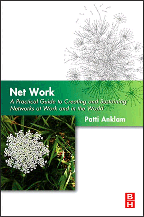Diffusion of innovation and the diffusion of understanding
Net Work work slowed a bit over the 4th of July holiday, but I’m back into it, thickly. An interesting morning, thinking about using network analysis question techniques to find the opinion leaders and influencers in an organization. My inquiry relates directly to finding the opinion leaders so as to create a network of change agents for organizational transformation: “in a very large organization, how do you find the people who are the most respected and listened to during times of change?”
I posted the question to ONA-prac, to see what others have been up to and then did a search of the SOCNET archives. The SOCNET search didn’t have much on the combination of “opinion leader” AND “change management.” When I shifted the search string slightly I found that I should have been inquiring about “innovation” AND “diffusion.” There’s quite a bit on that, and I found some good work by Tom Valente, whose special focus is on the diffusion of innovation through social networks in healthcare and medicine. The basic principles are also described by SNA researcher Ron Burt , who says that opinion “leaders” are more precisely information “brokers” who are the edge of things rather than at the top.
It all, of course, goes back to Everett Rogers’s classic adoption curve, which was the basis of Geoffrey Moore’s Crossing the Chasm. Network theory helps us understand the workings of how innovations spread across boundaries. Given a bell-shaped curve of innovators, early adopters, early majority, late majority, and laggards, the network theory illustrates the role of the brokers in bringing new ideas from the innovators “across the chasm” to the early adopters.
Which brings me to the current issue of Harvard Business Review, and a fascinating article, Better Sales Networks. In this article, Tuba Ustuner and David Godes provide insights into what the personal social networks of salespeople need to look like for different phases of the sales cycle: identifying prospects, gaining buy-in and upselling, creating solutions, and closing the deal. The network maps provide an interesting insight into brokerage and closure. Open networks are needed for the first two phases, for getting access through weak ties to more prospects, finding people to support making the connections with customers and establishing credibility. The next two stages require closure of the networks — bringing people together into a focused team to help craft a custom proposal and connecting the prospective customer with existing customers to cement the rleationship.
After I read this article, it occurred to me that here is another example of how understanding about the structure of personal, social, and organizational networks is starting to move from early adopters to the early majority. I pick up an HBR special double issue on Sales and think there may not be much to interest me, and I discover how the insights of this no-longer-quite-new field of network analysis are being diffused throughout the business world.




